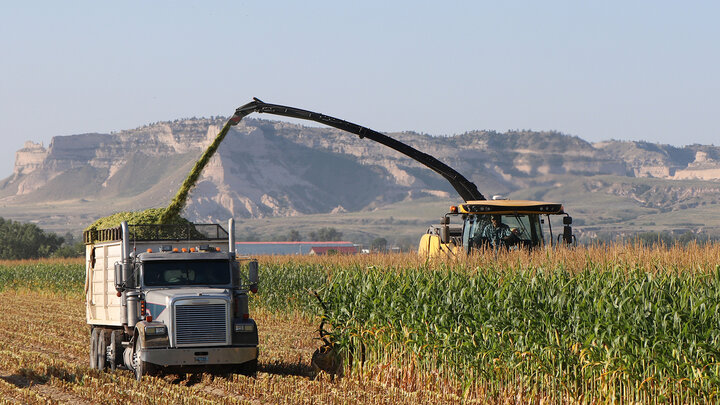Started in 1912, the Knorr-Holden Plot near Scottsbluff is perhaps the world’s oldest irrigated continuous corn research plot. It was recently commemorated with a sign to mark its significance to both Nebraska history and agricultural research history in Nebraska.
Records of the Knorr-Holden Plot date back to the early settlement of the Nebraska Panhandle and the 1902 Reclamation Act. In 1910, the U.S. Department of Agriculture, in cooperation with the Nebraska Experiment Sation, created the Scottsbluff Experiment Substation on 160 acres of unclaimed land north of Scottsbluff. The experiment station was eventually taken under the University of Nebraska-Lincoln (UNL) umbrella and has evolved to be included in the Panhandle Research, Extension and Education Center (PREEC), which now administers the original land.
After establishing the 160 acres for research purposes, prairie land was broken out and seeded to oats first. In 1912, substation superintendent, Fritz Knorr initiated an extensive series of irrigated and dryland cropping rotation experiments at the substation. Five years later, in 1917, the second superintendent, James Holden, continued the rotation plots, establishing further continuity of the historic corn plot when in 1941, all but the irrigated corn plots were discontinued.

It is because of Knorr and Holden’s initial conception and dedication to sustaining the research corn plots that the acres are known today as the Knorr-Holden Plot.
In 1942, the plot was subdivided to include beef cattle manure applications, and in 1953, inorganic nitrogen fertilizer was introduced as a subplot in the experimental design.
It has been previously documented that over the last 100-plus years, more than 30 scientists and graduate students have worked on the corn plot and published valuable data at national meetings, as well as published in numerous articles, bulletins and scientific journals.
In 1992, an effort was undertaken by plot superintendent at the time, Gary Hergert, UNL emeritus professor, soil and nutrient management specialist at PREEC, and his research technician, Rex Nielson, now retired, to permanently distinguish the research plot as a historical location. On May 11, 1992, the National Register of Historic Places – the official list of the Nation’s historic places worthy of preservation – entered the Knorr-Holden Continuous Corn Plot located in Scotts Bluff County to its list.
Today, the Knorr-Holden plot is supervised by Bijesh Maharjan, UNL associate professor, soil and nutrient management specialist at PREEC. Maharjan was the lead author of a manuscript published in 2021 in Agronomy Journal detailing the corn yields from manure and mineral fertilizers from a century of research data. Irrigated corn yield, yield stability, and reliability from organic and inorganic fertilizers were evaluated across years that included weather-induced yield losses – early or late frost, hail, and drought, most notably. The article emphasized the implications of long-term management practices effects on corn productivity and soil properties.
While analyzing the 100 years of yield data, Maharjan and a research team realized the greater significance of the Knorr-Holden Plot. The historical plot, which began in 1912 when native land was turned, is one of five of the oldest continuous field-crop experiments in the United States. Maharjan said the Knorr-Holden plot is also the oldest irrigated corn research plot and the third-oldest corn research plot in North America, possibly the world.
Considering the historical significance of the Knorr-Holden Plot, Maharjan, with the help of Dave Ostdiek, retired UNL PREEC communications specialist, was resolved to commemorate the plot – often seen as simply another Nebraska corn field – with a signboard depicting the land’s prestige. Once the concept was brainstormed in 2021, Ostdiek began a search through the Nebraska Experiment Substation and later UNL PREEC’s archives to piece together photographs depicting the historical value of the research plot.
“My role was to pick out the important information, edit it down to the amount of text that would fit into that sign area, and then find some photos that could help illustrate it,” Ostdiek said.
Ostdiek used information provided by Maharjan and past faculty and staff who had worked on the plot, along with photos from the archives of PREEC. Possibly his greatest challenge was finding quality photos of Knorr and Holden, eventually identifying Holden standing in a research plot and contacting another organization for a faculty photo of Knorr.
“I contacted Modesto Community College, and they just happened to have a PowerPoint with a photo of Fritz Knorr. They sent that, and I was able to create a digital copy with acceptable resolution,” Ostdiek said. “Holden was identified in an archival photo standing in a plot of wheat. From that, I could look at other photos and found that James Holden, indeed, appeared in a bunch of those photos.”
After a lengthy search and design effort and prolonged manufacturing, the commemorative sign was placed in the ground, just feet from the historical corn plot in August 2023. UNL IANR Senior Associate Vice Chancellor Ron Yoder and Richard Bischoff, UNL IANR associate vice chancellor, unveiled the sign on Aug. 23. Since then, the sign has been visited by a cohort of UNL administrators, including UNL IANR Vice President and Vice Chancellor Mike Boehm, UNL CASNR Dean Tiffany Heng-Moss, UNL PREEC Director John Westra, and Martha Mamo, UNL IANR Agronomy and Horticulture Department Head – to name a few – in early September.

"This sign will remind visitors of Nebraska’s visionary leadership, rich research history, and their roles in the livelihoods of our citizens,” Maharjan said. “I hope this sign will motivate all of us to continue making impactful contributions to ag research and literacy.”




